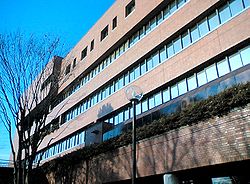Hino, Tokyo
Hino
日野市 | |
|---|---|
 Hino City Hall | |
 Flag  Seal | |
 Location of Hino in Tokyo Metropolis | |
 Hino | |
| Coordinates: 35°40′16.6″N 139°23′42.5″E / 35.671278°N 139.395139°ECoordinates: 35°40′16.6″N 139°23′42.5″E / 35.671278°N 139.395139°E | |
| Country | Japan |
| Region | Kantō |
| Prefecture | Tokyo |
| Government | |
| • Mayor | Fuyuhiko Otsubo (since April 2013) |
| Area | |
| • Total | 27.55 km2 (10.64 sq mi) |
| Population (April 2021) | |
| • Total | 187,048 |
| • Density | 6,800/km2 (18,000/sq mi) |
| Time zone | UTC+9 (Japan Standard Time) |
| City symbols | |
| • Tree | Live oak |
| • Flower | Chrysanthemum |
| • Bird | Common kingfisher |
| Phone number | 042-585-1111 |
| Address | 1-12-1 Shimmei, Hino-shi, Tokyo-to 191-8686 |
| Website | Official website |

Hino (日野市, Hino-shi) is a city located in the western portion of Tokyo Metropolis, Japan. As of 1 April 2021, the city had an estimated population of 187,048, and a population density of 6800 persons per km².[1] The total area of the city was 27.55 square kilometres (10.64 sq mi).
Geography[]
Hino is in Western Tokyo. The city has three geographical regions. The western part is called the Hino plateau, approximately 100 meters above sea level. The southern part is Tama Hills, between 150 and 200 meters above sea level. The eastern part of the city is an alluvial plain of the Tama River.
Surrounding municipalities[]
Tokyo Metropolis
Climate[]
Hino has a Humid subtropical climate (Köppen Cfa) characterized by warm summers and cool winters with light to no snowfall. The average annual temperature in Hino is 13.9 °C. The average annual rainfall is 1647 mm with September as the wettest month. The temperatures are highest on average in August, at around 25.4 °C, and lowest in January, at around 2.9 °C.[2]
Demographics[]
Per Japanese census data,[3] the population of Musashino increased rapidly in the 1950s through 1980s, but has remained relatively constant for the past 40 years.
| Year | Pop. | ±% |
|---|---|---|
| 1920 | 8,150 | — |
| 1930 | 9,175 | +12.6% |
| 1940 | 12,476 | +36.0% |
| 1950 | 24,444 | +95.9% |
| 1960 | 43,394 | +77.5% |
| 1970 | 98,557 | +127.1% |
| 1980 | 145,448 | +47.6% |
| 1990 | 165,928 | +14.1% |
| 2000 | 167,942 | +1.2% |
| 2010 | 179,646 | +7.0% |
History[]
The area of present-day Hino was part of ancient Musashi Province. During the Edo period, the village of Hino developed as a post station on the Kōshū Kaidō.
In the post-Meiji Restoration cadastral reform of 1871, Hino-juku became part of Kanagawa Prefecture. In the reorganization of districts in 1889, Hino-juku came under the jurisdiction of Minamitama District. The entire district was transferred to the control of Tokyo Prefecture on April 1, 1893, at which time Hino-juku was proclaimed Hino Town under the modern municipalities system. The area of the town expanded through annexation of neighboring villages in 1901 and 1958. On November 3, 1963, Hino was elevated to city status.
Government[]
Hino has a mayor-council form of government with a directly elected mayor and a unicameral city council of 24 members. Hino contributes two members to the Tokyo Metropolitan Assembly. In terms of national politics, the city is part of of the lower house of the Diet of Japan.
Politics[]
Economy[]
Hino is largely a regional commercial center and bedroom community for central Tokyo.
Hino is the hometown of Orient Watch Co., Ltd. established in 1950 by Shogoro Yoshida.[4]
On December 22, 2008, operations of Seiko Epson's Tokyo sales office began at Seiko Epson's Hino Office. Previously operations were at the World Trade Center in Minato, Tokyo.[5][6]
Hino also houses the headquarters of Hino Motors, a Toyota Group company producing semi-trailer trucks (British and Irish: articulated lorries), box trucks and buses.
Education[]
Universities[]
- Tokyo Metropolitan University – Hino campus
- Meisei University
- Jissen Women's University
- Sugino Fashion College – Hino campus
Primary and secondary[]
Hino has 17 public elementary schools and eight public middle schools operated by the Hino City Board of Education, and three public high schools operated by the Tokyo Metropolitan Government Board of Education.
Transportation[]

Railway[]
![]() JR East – JR East – Chūō Main Line
JR East – JR East – Chūō Main Line
![]() Keio Corporation - Keio Corporation – Keiō Line
Keio Corporation - Keio Corporation – Keiō Line
![]() Keio Corporation - Keio Corporation – Keiō Dōbutsuen Line
Keio Corporation - Keio Corporation – Keiō Dōbutsuen Line
![]() Tokyo Tama Intercity Monorail - Tama Toshi Monorail Line
Tokyo Tama Intercity Monorail - Tama Toshi Monorail Line
Highway[]
 Chūō Expressway
Chūō Expressway National Route 20 (Hino Bypass)
National Route 20 (Hino Bypass)
Local attractions[]
Sister cities[]
 Redlands, California, United States, from February 2004
Redlands, California, United States, from February 2004 Shiwa, Iwate Prefecture, Japan,[7] from January 2017
Shiwa, Iwate Prefecture, Japan,[7] from January 2017
Notable people from Hino[]
This section does not cite any sources. (August 2012) |
- Hijikata Toshizō, Bakumatsu period samurai
- Tomonobu Hiroi, Professional soccer player
- Inoue Genzaburō, Bakumatsu period samurai
- Yuzo Koshiro, composer
- Yuriko Yamamoto, voice actress
See also[]
References[]
- ^ "Hino city official statistics" (in Japanese). Japan.
- ^ Hino climate data
- ^ Hino population statistics
- ^ Orient Watch History Archived 2012-01-10 at the Wayback Machine, (in Japanese). Retrieved 3 October 2014
- ^ "Notice Regarding Relocation of Epson Imaging Devices Tokyo Sales Office." Seiko Epson. December 22, 2008. Retrieved on January 13, 2009.
- ^ "Information." World Trade Center Tokyo. Retrieved on January 13, 2009.
- ^ 日野市と紫波町. Hino City Official Website (in Japanese). Retrieved 29 July 2018.
External links[]
| Wikimedia Commons has media related to Hino, Tokyo. |
- Hino City Official Website (in Japanese)
- Hino, Tokyo
- Cities in Tokyo
- Western Tokyo

